
Cosby, Tennessee
Encyclopedia
Cosby is an unincorporated community
in Cocke County, Tennessee
, United States
. Although it is not a census-designated place
, the ZIP Code Tabulation Area
for the ZIP Code
(37722) that serves Cosby had a population of 5,201 as of the 2000 U.S. Census. The community has given its name to the northeastern section of the Great Smoky Mountains National Park
, which forms its southern boundary.
Of the 2,091 households, 31.3% had children under the age of 18 living with them, 56.8% were married couples
living together, 11.9% had a female householder with no husband present, and 27.1% were non-families. 22.1% of all households were made up of individuals and 21.8% had someone living alone who was 65 years of age or older. The average household size was 2.49 and the average family size was 2.89.
76.2% of the population was 18 years of age or older with 14.4% being 62 years of age or older. The median age was 38.1 years. The population was 48.1% male and 51.9% female.
The median income for a household in the area was $26,533, and the median income for a family was $30,444. The per capita income
for the city was $12,992. About 9.2% of families and 12.4% of the population were below the poverty line.
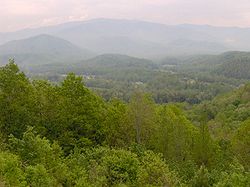 Cosby is located at 35°49′02"N 83°14′49"W (35.8172, -83.2469).http://www.topozone.com/map.asp?lat=35.81722&lon=-83.24694 The community is spread out over a narrow valley that runs from Allen Grove near Newport
Cosby is located at 35°49′02"N 83°14′49"W (35.8172, -83.2469).http://www.topozone.com/map.asp?lat=35.81722&lon=-83.24694 The community is spread out over a narrow valley that runs from Allen Grove near Newport
in the north to the border of the national park to the south. English Mountain rises over 2,000 feet above Cosby to the northwest and Green Mountain rises just over 1,500 feet to the east. The Smokies are to the south and southwest.
Cosby Creek, its source on the crest of the Smokies near Cammerer Ridge
, is the valley's main watershed. The creek cuts through the valley, running roughly parallel to Tennessee Route 32 before turning east near Allen Grove and emptying into the Pigeon River.
Traditionally, Cosby has been divided into three sections, known simply as "Lower Cosby," "Middle Cosby," and "Upper Cosby." Lower Cosby is the northernmost section, roughly consisting of the area between the mouth of Cosby Creek along the Pigeon River and Jones Cove Road. Upper Cosby, most of which is now part of the national park, consists mainly of the area in the vicinity of the Cosby Campground.
U.S. Route 321
is the main road in Cosby, connecting the valley to Newport (10 miles to the north) and Gatlinburg (20 miles to the west). TN-339, which intersects US-321 near the center of Cosby, connects the valley with Jones Cove and Sevierville to the west. TN-32 parallels US-321 through most of Cosby before splitting off and heading east to the Cosby section of the national park and onward to the Tennessee-North Carolina border.
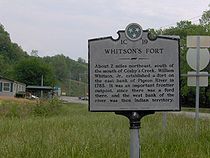 For centuries, lands along the northern rim of the Great Smokies, including Cosby, were used primarily as hunting grounds by the Cherokee
For centuries, lands along the northern rim of the Great Smokies, including Cosby, were used primarily as hunting grounds by the Cherokee
. The first European settlers arrived in what is now Cocke County in the early 1780s. Among these settlers were John Gilliland (c. 1725-1798), who settled near the mouth of the Pigeon River, Peter Fine (1753–1826), who established Fine's Ferry at what is now Newport, and a small colony of German immigrants from Pennsylvania, who settled in what became known as the Dutch Bottoms area. Samuel Odell (c. 1750-1789) was probably the first to settle in the Cosby Creek valley.
These early encroachments no doubt agitated the Cherokee, who harassed the early settlers by stealing their livestock.
Fine's brother, Vinet, was killed while chasing a band of Cherokee raiders in 1783. Scalpings were also reported. In response to these attacks, William Whitson (c. 1739-1819) erected a small fort just south of where Cosby Creek empties into the Pigeon River. The fort quickly grew into a small frontier outpost, complementing the fords and ferry to the north. While Cherokee raids continued, the Cosby area was largely peaceful by the early 19th century.
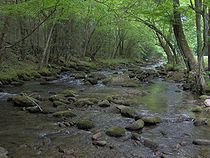 The origin of the name "Cosby" is a mystery, although there are two well-established hypotheses.
The origin of the name "Cosby" is a mystery, although there are two well-established hypotheses.
The first centers around an early trapper and distiller in the area named Jonathan Cosby (sometimes spelled "Cozby"). The second suggests that the creek and valley were named after Dr. James Cozby (c. 1752-1831), a Revolutionary War
veteran and friend of John Sevier
, who may have made early claims to land along the creek. In any case, the name appears as early as 1838 in the minutes of the Big Pigeon Church in reference to the Bethany Church that had recently been founded along "Cosby Creek."
Cocke County, like much of East Tennessee, was divided between Union
and Confederate
sentiments during the American Civil War
. Like most mountain communities, Cosby was subject to raids throughout the war, especially from Confederate marauders crossing the mountains from North Carolina. A "home guard" camp was eventually established at the mouth of Indian Camp creek.http://www.sevierlibrary.org/ahgp/Origins.htm
In the late 19th century, Cosby slowly recovered from the effects of the war. The community benefited to some extent from the railroad stations established at Newport and Big Creek (between Cosby and Newport) in 1867 and the 1870s, respectively. In the 1890s, a lumber mill was established at nearby Hartford
, adjacent to the Tennessee-North Carolina border.
Some supplemented their income by gathering ginseng, evergreens, and moss in the mountains, and some distilled corn liquor. Religion was still of utmost importance.
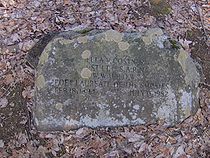 Most church services were held once every month, usually in framed buildings. Mary Bell Smith, who grew up in Cosby in the 1920s, remembered:
Most church services were held once every month, usually in framed buildings. Mary Bell Smith, who grew up in Cosby in the 1920s, remembered:
With the construction of railroads between Newport and Hartford, the Progressive Era
began to make its way to the Smokies. Electricity had arrived in the sawmill towns in the 1920s. Still, Cosby lagged behind. Although the Baptist Church Organization established Cosby Academy in 1913, most of Cosby's children received brief instruction in rudimentary schoolhouses. Mary Bell Smith recalled:
With the arrival of the Great Depression
, many of the sawmills, including the Boice Hardwood mill at Hartford, shut down. Most farmers had difficulty selling their crops, and some were forced to turn to moonshining (see below). Many of the mountain people survived the Depression due to their hunting skills. Smith remembered her father waking up before sunrise and "returning with several squirrels" for the family breakfast. The pains of the Depression were eased when the Civilian Conservation Corps
established a camp at what is now Cosby Creek Campground to construct trails for the newly-created Great Smoky Mountains National Park
, and the TVA
began work on Douglas Dam
on the other side of English Mountain.
Unlike many other Smoky Mountain communities, such as Cades Cove
and the Sugarlands, only part of Cosby was incorporated into the national park. Many farmers were indeed glad to sell their land, but according to Mary Bell Smith:
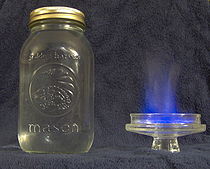 For much of the first half of the 20th century, Cosby was known to East Tennesseans as "The Moonshine Capital of the World." Of Cosby's moonshiners, Smith recalled:
For much of the first half of the 20th century, Cosby was known to East Tennesseans as "The Moonshine Capital of the World." Of Cosby's moonshiners, Smith recalled:
Like other Appalachian communities at the base of the Smokies, Cosby's chief crop was corn. While corn could be grown on relatively steep grades, the soil in Cosby's hilly recesses grew poorer and poorer with every clearing. Eventually, farmers struggled to break even, and in the late 19th century began to supplement their income by selling moonshine.
The deep winding coves and thick forests of the Smokies were the perfect cover for moonshine stills. As liquor supplies were strained with the rise of prohibition
in the early 20th century, demand for the mountaineers' moonshine grew steadily. While many mountain communities were difficult to access, Cosby was connected by road to Newport and Knoxville, giving it an early advantage. Furthermore, Cosby never managed to attract the tourism dollars that spilled into other park border towns, such as Gatlinburg and Townsend
. It is therefore no surprise that moonshining became such an issue in the Cosby valley.
During World War II
, the Manhattan Project
at what is now Oak Ridge
brought in people from all over the country. As many were unaccustomed to the dry laws that were prevalent in Tennessee at the time, they were forced to turn to illegally distilled liquor. This pushed the demand in Cosby still higher. Cosby's moonshiners dealt with the sugar shortage brought about by the war by taking advantage of a government supplement of sugar to any farmer who kept beehives. According to Appalachian historian Wilma Dykeman
, "beehives sprouted around mountain cabins like weeds in a seedbed."
The explosion of moonshining in the Cosby area would lead to a cat-and-mouse game between law enforcement and moonshiners. The illegal distillers would warn one another of approaching revenue agents by setting off dynamite
. Other times, locals would drive behind agents' cars, leading to a long tailgate along the road through the valley. Revenue officials could not rely on the residents of Cosby, who shunned intrusion by outside law enforcement. Moonshiners devised various methods for avoiding detection. Smith recalls:
Eventually, competition between moonshiners led some to inform on others. Violence often erupted between rival families. The practice of illegally distilling liquor largely declined with the demise of dry laws in various counties around East Tennessee. While most residents of Cosby were no doubt law-abiding citizens, the notoriety the town gained as a moonshine mecca still hangs over it today.
Unincorporated area
In law, an unincorporated area is a region of land that is not a part of any municipality.To "incorporate" in this context means to form a municipal corporation, a city, town, or village with its own government. An unincorporated community is usually not subject to or taxed by a municipal government...
in Cocke County, Tennessee
Tennessee
Tennessee is a U.S. state located in the Southeastern United States. It has a population of 6,346,105, making it the nation's 17th-largest state by population, and covers , making it the 36th-largest by total land area...
, United States
United States
The United States of America is a federal constitutional republic comprising fifty states and a federal district...
. Although it is not a census-designated place
Census-designated place
A census-designated place is a concentration of population identified by the United States Census Bureau for statistical purposes. CDPs are delineated for each decennial census as the statistical counterparts of incorporated places such as cities, towns and villages...
, the ZIP Code Tabulation Area
ZIP Code Tabulation Area
ZIP Code Tabulation Areas are statistical entities developed by the United States Census Bureau for tabulating summary statistics from Census 2000. This new entity was developed to overcome the difficulties in precisely defining the land area covered by each ZIP code...
for the ZIP Code
ZIP Code
ZIP codes are a system of postal codes used by the United States Postal Service since 1963. The term ZIP, an acronym for Zone Improvement Plan, is properly written in capital letters and was chosen to suggest that the mail travels more efficiently, and therefore more quickly, when senders use the...
(37722) that serves Cosby had a population of 5,201 as of the 2000 U.S. Census. The community has given its name to the northeastern section of the Great Smoky Mountains National Park
Great Smoky Mountains National Park
Great Smoky Mountains National Park is a United States National Park and UNESCO World Heritage Site that straddles the ridgeline of the Great Smoky Mountains, part of the Blue Ridge Mountains, which are a division of the larger Appalachian Mountain chain. The border between Tennessee and North...
, which forms its southern boundary.
Demographics
As of the census of 2000, there were 5,201 people, 2,091 households, and 1,525 families residing in the Zip Code Tabulation Area for the zip code (37722) that serves Cosby. The racial makeup of this area was 98.8% White, 1% Native American and 0.2% Asian, and 0.2% African American. Hispanics and Latinos comprise 0.9% of the population.Of the 2,091 households, 31.3% had children under the age of 18 living with them, 56.8% were married couples
Marriage
Marriage is a social union or legal contract between people that creates kinship. It is an institution in which interpersonal relationships, usually intimate and sexual, are acknowledged in a variety of ways, depending on the culture or subculture in which it is found...
living together, 11.9% had a female householder with no husband present, and 27.1% were non-families. 22.1% of all households were made up of individuals and 21.8% had someone living alone who was 65 years of age or older. The average household size was 2.49 and the average family size was 2.89.
76.2% of the population was 18 years of age or older with 14.4% being 62 years of age or older. The median age was 38.1 years. The population was 48.1% male and 51.9% female.
The median income for a household in the area was $26,533, and the median income for a family was $30,444. The per capita income
Per capita income
Per capita income or income per person is a measure of mean income within an economic aggregate, such as a country or city. It is calculated by taking a measure of all sources of income in the aggregate and dividing it by the total population...
for the city was $12,992. About 9.2% of families and 12.4% of the population were below the poverty line.
Geography

Newport, Tennessee
Newport is a city in Cocke County, Tennessee, United States. The population was 7,242 at the 2000 census. It is the county seat of Cocke County.-Geography:...
in the north to the border of the national park to the south. English Mountain rises over 2,000 feet above Cosby to the northwest and Green Mountain rises just over 1,500 feet to the east. The Smokies are to the south and southwest.
Cosby Creek, its source on the crest of the Smokies near Cammerer Ridge
Mount Cammerer
Mount Cammerer is a mountain on the northeastern fringe of the Great Smoky Mountains, in the Southeastern United States. The mountain is situated on the state line between Cocke County, Tennessee and Haywood County, North Carolina...
, is the valley's main watershed. The creek cuts through the valley, running roughly parallel to Tennessee Route 32 before turning east near Allen Grove and emptying into the Pigeon River.
Traditionally, Cosby has been divided into three sections, known simply as "Lower Cosby," "Middle Cosby," and "Upper Cosby." Lower Cosby is the northernmost section, roughly consisting of the area between the mouth of Cosby Creek along the Pigeon River and Jones Cove Road. Upper Cosby, most of which is now part of the national park, consists mainly of the area in the vicinity of the Cosby Campground.
U.S. Route 321
U.S. Route 321
U.S. Route 321 is a spur of U.S. Route 21. It runs for 526 miles from South Carolina to Tennessee. The northern terminus of U.S. 321 is between Lenoir City and Oak Ridge, Tennessee, at Interstate 40 exit 364, which is about 4 miles west of Interstate 40's junction with Interstate 75...
is the main road in Cosby, connecting the valley to Newport (10 miles to the north) and Gatlinburg (20 miles to the west). TN-339, which intersects US-321 near the center of Cosby, connects the valley with Jones Cove and Sevierville to the west. TN-32 parallels US-321 through most of Cosby before splitting off and heading east to the Cosby section of the national park and onward to the Tennessee-North Carolina border.
Early history

Cherokee
The Cherokee are a Native American people historically settled in the Southeastern United States . Linguistically, they are part of the Iroquoian language family...
. The first European settlers arrived in what is now Cocke County in the early 1780s. Among these settlers were John Gilliland (c. 1725-1798), who settled near the mouth of the Pigeon River, Peter Fine (1753–1826), who established Fine's Ferry at what is now Newport, and a small colony of German immigrants from Pennsylvania, who settled in what became known as the Dutch Bottoms area. Samuel Odell (c. 1750-1789) was probably the first to settle in the Cosby Creek valley.
These early encroachments no doubt agitated the Cherokee, who harassed the early settlers by stealing their livestock.
Fine's brother, Vinet, was killed while chasing a band of Cherokee raiders in 1783. Scalpings were also reported. In response to these attacks, William Whitson (c. 1739-1819) erected a small fort just south of where Cosby Creek empties into the Pigeon River. The fort quickly grew into a small frontier outpost, complementing the fords and ferry to the north. While Cherokee raids continued, the Cosby area was largely peaceful by the early 19th century.
19th century

The first centers around an early trapper and distiller in the area named Jonathan Cosby (sometimes spelled "Cozby"). The second suggests that the creek and valley were named after Dr. James Cozby (c. 1752-1831), a Revolutionary War
American Revolutionary War
The American Revolutionary War , the American War of Independence, or simply the Revolutionary War, began as a war between the Kingdom of Great Britain and thirteen British colonies in North America, and ended in a global war between several European great powers.The war was the result of the...
veteran and friend of John Sevier
John Sevier
John Sevier served four years as the only governor of the State of Franklin and twelve years as Governor of Tennessee. As a U.S. Representative from Tennessee from 1811 until his death...
, who may have made early claims to land along the creek. In any case, the name appears as early as 1838 in the minutes of the Big Pigeon Church in reference to the Bethany Church that had recently been founded along "Cosby Creek."
Cocke County, like much of East Tennessee, was divided between Union
Union (American Civil War)
During the American Civil War, the Union was a name used to refer to the federal government of the United States, which was supported by the twenty free states and five border slave states. It was opposed by 11 southern slave states that had declared a secession to join together to form the...
and Confederate
Confederate States of America
The Confederate States of America was a government set up from 1861 to 1865 by 11 Southern slave states of the United States of America that had declared their secession from the U.S...
sentiments during the American Civil War
American Civil War
The American Civil War was a civil war fought in the United States of America. In response to the election of Abraham Lincoln as President of the United States, 11 southern slave states declared their secession from the United States and formed the Confederate States of America ; the other 25...
. Like most mountain communities, Cosby was subject to raids throughout the war, especially from Confederate marauders crossing the mountains from North Carolina. A "home guard" camp was eventually established at the mouth of Indian Camp creek.http://www.sevierlibrary.org/ahgp/Origins.htm
In the late 19th century, Cosby slowly recovered from the effects of the war. The community benefited to some extent from the railroad stations established at Newport and Big Creek (between Cosby and Newport) in 1867 and the 1870s, respectively. In the 1890s, a lumber mill was established at nearby Hartford
Hartford, Tennessee
Hartford is an unincorporated community in Cocke County, Tennessee, located in the southeastern United States. Although it is not a census-designated place, the ZIP Code Tabulation Area for the ZIP Code that serves Hartford had a population of 814, according to the 2000 census.Hartford is the...
, adjacent to the Tennessee-North Carolina border.
Early 20th century
By 1900, most Cosby residents were either farmers or worked in lumber mills.Some supplemented their income by gathering ginseng, evergreens, and moss in the mountains, and some distilled corn liquor. Religion was still of utmost importance.

Sermons were long and harrowing. In vivid language, the preacher painted Heaven and Hell, with considerably more emphasis on Hell than upon Heaven. I mentally pictured the Devil as a monstrous red animal with horns and a long tail, who carried a four-pronged pitchfork. For some reason, I believed he lived in the ground and could appear at will. The church had no organ or piano, so we sang without instruments.
With the construction of railroads between Newport and Hartford, the Progressive Era
Progressive Era
The Progressive Era in the United States was a period of social activism and political reform that flourished from the 1890s to the 1920s. One main goal of the Progressive movement was purification of government, as Progressives tried to eliminate corruption by exposing and undercutting political...
began to make its way to the Smokies. Electricity had arrived in the sawmill towns in the 1920s. Still, Cosby lagged behind. Although the Baptist Church Organization established Cosby Academy in 1913, most of Cosby's children received brief instruction in rudimentary schoolhouses. Mary Bell Smith recalled:
The one-room school building was only about thirty by fifty feet and rested on stone pillars about four feet off the ground at the front entrance. Inside a chalk-board stretched across the back wall, and a pot-bellied stove stood near the center of the room. A water bucket, a tin dipper, six erasers, and a broom completed the educational supplies.
With the arrival of the Great Depression
Great Depression
The Great Depression was a severe worldwide economic depression in the decade preceding World War II. The timing of the Great Depression varied across nations, but in most countries it started in about 1929 and lasted until the late 1930s or early 1940s...
, many of the sawmills, including the Boice Hardwood mill at Hartford, shut down. Most farmers had difficulty selling their crops, and some were forced to turn to moonshining (see below). Many of the mountain people survived the Depression due to their hunting skills. Smith remembered her father waking up before sunrise and "returning with several squirrels" for the family breakfast. The pains of the Depression were eased when the Civilian Conservation Corps
Civilian Conservation Corps
The Civilian Conservation Corps was a public work relief program that operated from 1933 to 1942 in the United States for unemployed, unmarried men from relief families, ages 18–25. A part of the New Deal of President Franklin D...
established a camp at what is now Cosby Creek Campground to construct trails for the newly-created Great Smoky Mountains National Park
Great Smoky Mountains National Park
Great Smoky Mountains National Park is a United States National Park and UNESCO World Heritage Site that straddles the ridgeline of the Great Smoky Mountains, part of the Blue Ridge Mountains, which are a division of the larger Appalachian Mountain chain. The border between Tennessee and North...
, and the TVA
Tennessee Valley Authority
The Tennessee Valley Authority is a federally owned corporation in the United States created by congressional charter in May 1933 to provide navigation, flood control, electricity generation, fertilizer manufacturing, and economic development in the Tennessee Valley, a region particularly affected...
began work on Douglas Dam
Douglas Dam
Douglas Dam is a hydroelectric dam on the French Broad River in Sevier County, Tennessee, in the southeastern United States. The dam is operated by the Tennessee Valley Authority , which built the dam in record time in the early 1940s to meet emergency energy demands at the height of World War II...
on the other side of English Mountain.
Unlike many other Smoky Mountain communities, such as Cades Cove
Cades Cove
Cades Cove is an isolated valley located in the Tennessee section of Great Smoky Mountains National Park, USA. The valley was home to numerous settlers before the formation of the national park...
and the Sugarlands, only part of Cosby was incorporated into the national park. Many farmers were indeed glad to sell their land, but according to Mary Bell Smith:
The day was mournful for many families when the government bought the Great Smokey Mountains and created a national park. Our friends and acquaintances who had lived there for generations had to find new homes and a new way of life.
Moonshining

So notorious did their activities become that I learned when I first went away from home that when I had to give my address as "Cosby," I should be ready to say, "Yes, they make it up there."
Like other Appalachian communities at the base of the Smokies, Cosby's chief crop was corn. While corn could be grown on relatively steep grades, the soil in Cosby's hilly recesses grew poorer and poorer with every clearing. Eventually, farmers struggled to break even, and in the late 19th century began to supplement their income by selling moonshine.
The deep winding coves and thick forests of the Smokies were the perfect cover for moonshine stills. As liquor supplies were strained with the rise of prohibition
Prohibition
Prohibition of alcohol, often referred to simply as prohibition, is the practice of prohibiting the manufacture, transportation, import, export, sale, and consumption of alcohol and alcoholic beverages. The term can also apply to the periods in the histories of the countries during which the...
in the early 20th century, demand for the mountaineers' moonshine grew steadily. While many mountain communities were difficult to access, Cosby was connected by road to Newport and Knoxville, giving it an early advantage. Furthermore, Cosby never managed to attract the tourism dollars that spilled into other park border towns, such as Gatlinburg and Townsend
Townsend, Tennessee
Townsend is a city in Blount County, Tennessee, in the southeastern United States. The population was 244 at the 2000 census. Townsend is one of three "gateways" to the Great Smoky Mountains National Park and the home of several museums and attractions relating to both the natural and human...
. It is therefore no surprise that moonshining became such an issue in the Cosby valley.
During World War II
World War II
World War II, or the Second World War , was a global conflict lasting from 1939 to 1945, involving most of the world's nations—including all of the great powers—eventually forming two opposing military alliances: the Allies and the Axis...
, the Manhattan Project
Manhattan Project
The Manhattan Project was a research and development program, led by the United States with participation from the United Kingdom and Canada, that produced the first atomic bomb during World War II. From 1942 to 1946, the project was under the direction of Major General Leslie Groves of the US Army...
at what is now Oak Ridge
Oak Ridge, Tennessee
Oak Ridge is a city in Anderson and Roane counties in the eastern part of the U.S. state of Tennessee, about west of Knoxville. Oak Ridge's population was 27,387 at the 2000 census...
brought in people from all over the country. As many were unaccustomed to the dry laws that were prevalent in Tennessee at the time, they were forced to turn to illegally distilled liquor. This pushed the demand in Cosby still higher. Cosby's moonshiners dealt with the sugar shortage brought about by the war by taking advantage of a government supplement of sugar to any farmer who kept beehives. According to Appalachian historian Wilma Dykeman
Wilma Dykeman
Wilma Dykeman Stokely was an American writer of fiction and nonfiction whose works chronicled the people and land of Appalachia.-Biography:...
, "beehives sprouted around mountain cabins like weeds in a seedbed."
The explosion of moonshining in the Cosby area would lead to a cat-and-mouse game between law enforcement and moonshiners. The illegal distillers would warn one another of approaching revenue agents by setting off dynamite
Dynamite
Dynamite is an explosive material based on nitroglycerin, initially using diatomaceous earth , or another absorbent substance such as powdered shells, clay, sawdust, or wood pulp. Dynamites using organic materials such as sawdust are less stable and such use has been generally discontinued...
. Other times, locals would drive behind agents' cars, leading to a long tailgate along the road through the valley. Revenue officials could not rely on the residents of Cosby, who shunned intrusion by outside law enforcement. Moonshiners devised various methods for avoiding detection. Smith recalls:
On my walks to the country store, I have stood barefoot, watching as the hauler carefully brushed away his tire tracks with pine boughs. Moonshine stills were well concealed within the dark recesses of the mountains, but the smoke still wafted skyward from points all over the green mountains. Not so easily concealed were the odor of the mash fermenting and the whump, whump, whump of the thump keg. On a rare occasion I saw a still in full operation on Sunday in sight of Caton's Grove Church.
Eventually, competition between moonshiners led some to inform on others. Violence often erupted between rival families. The practice of illegally distilling liquor largely declined with the demise of dry laws in various counties around East Tennessee. While most residents of Cosby were no doubt law-abiding citizens, the notoriety the town gained as a moonshine mecca still hangs over it today.
Education
- The Cosby community is served by Cosby High School, which is part of the Cocke County Schools System. Its mascot is the "Eagles."

